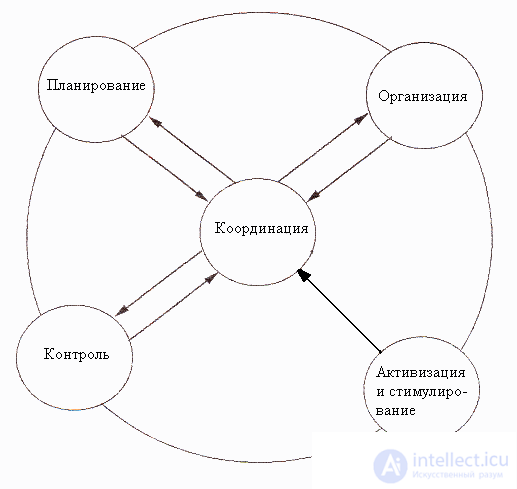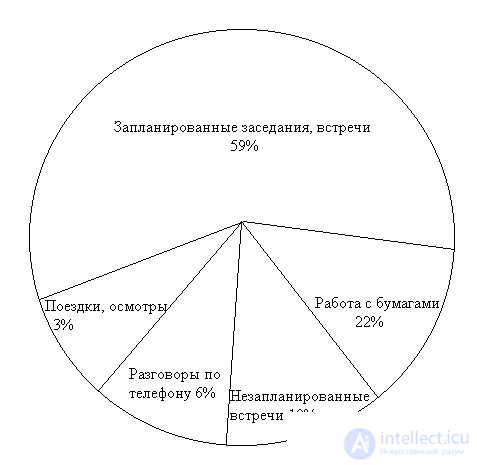Lecture
The planning and coordination function is closely related to the planning function, which is carried out by the governing bodies in the process of implementing the plans.
Regulation is the activity of maintaining specified parameters in a dynamic production control system. It is determined by the task of maintaining the state of orderliness both in the production subsystem and in the management subsystem. This view of the regulatory function is the most common in the domestic literature. This is exactly the function that connects the control system with the external environment.
The regulation function is determined by the norm: in its field of vision is any deviation from the norm. Regulation consists in achieving such an activity of the system, in which all deviations of a state from a predetermined value are eliminated.
The constant dynamism of production is associated with continuous changes in the situation, generated by both the movement of the system itself and disturbing influences of the environment. Changes in the production itself are taken into account due to dispatching, which is a specific form of operational regulation. Disturbing effects of the external environment occur, primarily in relations between enterprises - horizontally, the consumer - supplier. Here, unfortunately, very frequent violations by counterparties of their supply obligations, etc., are observed, which greatly complicates the regulation. However, under all conditions, the control body, through the regulation function, must use various methods (equalization of deviations, compensation of disturbances, elimination of interference effects) to ensure the preservation of the set parameters.
Coordination ensures coherence in the time and space of government bodies and officials, as well as between the system as a whole and the external environment.
The coordination function plays a role in production management, which figuratively can be compared with the role of a conductor in an orchestra. It is thanks to it that the dynamism of the production system is ensured, a harmony of interconnections of production units is created, and technological and labor resources are maneuvered within the enterprise due to changes in technical and economic tasks.
The object of the coordination function is both managed and control subsystems. Coordination of the activities of management bodies is designed to ensure the unity of actions of all management units, management workers and specialists for the most effective impact on the production process.
Thus, coordination of activities means synchronization of the efforts made, their integration into a single whole, that is, the process of distributing activities over time, bringing its individual elements into such a combination that would most effectively and efficiently achieve their goals.
Coordination is the central function of the management process, ensuring, firstly, its continuity and continuity and, secondly, the interrelation of all functions (see. Fig. 3.10). The main task of coordination is to achieve consistency in the work of all levels of the organization through the establishment of rational connections (communications) and the exchange of information between them.
Communication is a process associated with interpersonal and organizational communication in the transmission of information both within the organization and with the external environment. It is through communications that information is transmitted to decision makers, and decisions are made to their performers.
As studies show, managers * spend most of their working time on communication, i.e., on the exchange of information (see Fig. 3. 11). The nature of these relationships can be very different, how it depends on coordinated processes. The most frequently used meetings, documents, reports, memos, computer and telephone communications, radio and television. With the help of these and other forms of communication, interaction between divisions of the organization is established, resources are maneuvered, unity and coordination of all stages of the management process (planning, organization of motivation and control), as well as actions of managers are ensured.
It is because the exchange of information is embedded in all major types of management activities, we call communication a link. This means that successful managers and organizations need effective communication to coordinate their activities. Ineffective communications, for example, in terms of time and quality, do not allow for effective coordination of the actions of people, groups, and the organization as a whole, as well as the performance of management functions.

Fig. 3. 10. The relationship of management functions.
Management * of production through the function of coordination, designed rationally, to organize numerous links based on their study and improvement. With the growth of the scale of production and its management, the development of the processes of specialization and cooperation in it, the number of connections is steadily increasing. The increase in the number of links is accompanied by an increase in the amount of information required for management. This complicates the management process. It is established that the number of links grows as a square of the number of production growth. If the volume of production will increase by 3 times, then the number of links is 9 times. On the contrary, reducing the number of connections leads to a simplification of the production process and its management. Hence the importance of studying the factors affecting the reduction in the number of connections. These include: improving the organization of labor, production and management.

Fig. 3. 11. The cost structure of the working time of the head []
In the conditions of growth of independence and responsibility of managers at all levels, the growth of so-called informal relations, which provide horizontal coordination of work performed at the same level of the management structure, occurs. In any management process there is a direct and feedback. Coordination is unthinkable without feedback. If there is feedback, the sender and recipient change communication roles. Information obtained through feedback channels allows the regulation of the production process. For example, if the production of any position of the monthly plan is lagging behind in terms and volume, it is necessary to develop a system of measures aimed at eliminating this lag. In this case, the coordination and regulation function ultimately ensures the achievement of the goals of the contractor, the group and the organization as a whole. From this it follows that feedback as communication * is very important, because it makes it possible to ensure the continuity of the management process.
Comments
To leave a comment
Management
Terms: Management